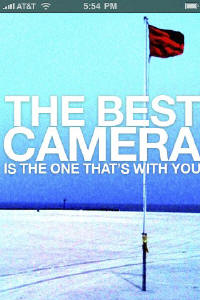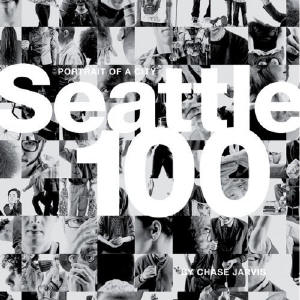Chris and Larry: You have no formal
training as a photographer, yet arguably youíre one of the top
photographers working today. Howíd you get there?
Chase Jarvis: I wish I could answer that in a sentence. I think
maybe the shortest description is by being incredibly curious and very
hardworking. And throw a whole bunch of luck in there too. Thereís a lot
of timing and luck involved in anything I do.
As for teaching myself how to be a photographer, it was very passion
driven. Even though learning some of the technical aspects required
dedication, it was all very centered on how I wanted to be spending my
time.
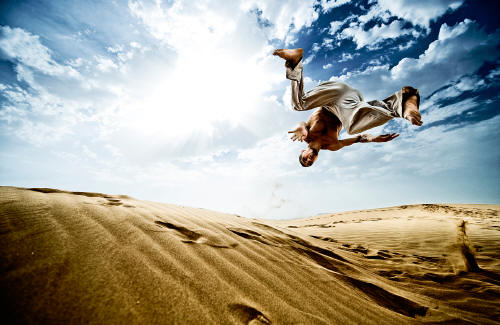
Chris and Larry: Whatís different about your approach?
Chase Jarvis: Itís really a great asset to be willing to fail and
blow it, so to speak, and to be okay with just making stuff, sharing it
and getting feedback. I coupled that with new socialization tools to get
my work out there in the world and get a lot of feedback.
Chris and Larry: Your use of social networking technology is pretty
impressive.
Chase Jarvis: Iím a hard working culture junkie who knows that itís
the greatest time in history to be a photographer or creative.
Itís the first time in the history of the world that creatives are also
distributors. And thatís very profound if you think that up until the
recent history, permission was required for us to be able to share work at
any sort of scale. We had to get permission from galleries, from ad
agencies or photo editors to be able to have our work out there. And now
anybody with access to a computer can show their work in 200 countries
around the world. So my adoption of new technology is about the
socialization of my work, creating and sharing work in ways that just were
not available in the past.
To be creative, you have to make stuff. If you sit around waiting for the
perfect idea, youíre never going to get anywhere. And it just so happens
that some good ideas occasionally float to the top.

Chris and Larry: And those are the ones hopefully people will
remember.
Chase Jarvis: Yeah, exactly. And the idea is if you put something
out that sucks, it fades away pretty quickly. And if you put out a concept
like the Best Camera or the first iPhone book that we did, those have some
sticking power and they will be around for a while.
Chris and Larry: At first it seems strange that a pro that shoots
with world class photographic equipment would publish a book of their
iPhone pictures. But you also came up with a wildly successful iPhone app
that made tweaking and sharing photos easy and a created an entire
community around it. How did the project grow to that scale? Was it
initially planned that way?
Chase Jarvis: My goal is never to make a project large scale. My
goal always stems from solving a creative problem or creative challenge.
At the most fundamental level of the whole iPhone movement was my desire
to have a visual journal. When the iPhone first came out I started taking
pictures with it every day. As someone who travels the world shooting
major ad campaigns with all the best equipment in the world, this little
camera that at first had only 2 megapixels suddenly gave me more creative
freedom than I felt like I had in my professional life. And that was
incredibly interesting and empowering for me.
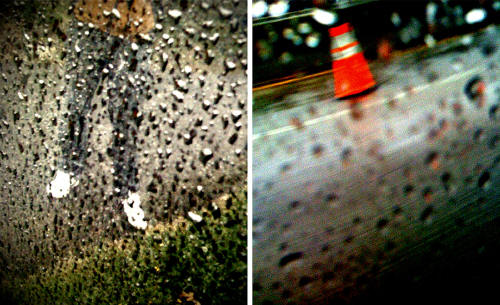
Suddenly gone was all the pressure to make the perfect picture. I was more
interested in the immediate and the now and the things that were near me,
and using that as kind of a study or sounding board for my other work.
Well, even that idea that this was just a sounding board for my other work
was quickly supplanted with, wait a minute, this is actually work in and
of itself. Itís conceptual artwork and itís informing, not just my
professional work, but my life. And the freedom it gave me was incredible.
All I wanted to do was then share that idea because it was rewarding for
me. So I started socializing my pictures and sharing them online every day
through different outlets like Facebook and Twitter. The feedback that I
got, not just from the pictures, but from the concept, was really
staggering. I think the first iPhone gallery that I put on my site
received two million views in something like 72 hours. The concept is
simple. The pictures arenít about megapixels or dynamic range, and all
those things that technical photographers talk about. Theyíre really about
stories and the moment, which I learned by first desiring a visual journal
and seeing the kind of feedback it got. When I started using the camera, I
realized that there were no apps out there that did exactly what I wanted
to do. So I made my own.
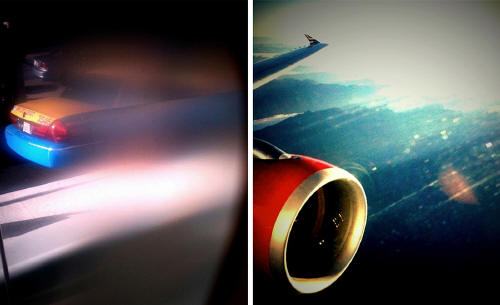
So thereís kind of this necessity is the mother of invention behind these
larger concepts. And then the community for that, in that case,
TheBestCamera.com
was just a logical extension to this thing that has changed my creative
life. I feel more creative now than ever before. I want to share that with
people to inspire them and say, hey, if I can do it, you can do it. I want
to give them a tool, like the iPhone app, and then give them a place to
put their creations at thebestcamera.com along with all their other social
channels. So it never starts out as a grand vision, I just went with it
and it all came together for me.
Chris and Larry: Like a snowball turning into an avalanche.
Chase Jarvis: Thatís exactly what it was. In reality, itís been
going on since I started taking pictures with my phone camera. I did wake
up at one point in the middle of the night and say, wait a minute, I got
this book coming out in a few months and weíve been working on this iPhone
app. There seemed to be a really cool tie-together. But it evolved very
organically and very naturally. Itís really been just kind of setting them
free at the same time that I feel like leads people to believe that it was
all conceived in one great creative session.
Chris and Larry: Would you say the feedback you get from social
media is an important part of your creative process?
Chase Jarvis: I think your characterization is accurate. For me, an
important part of this whole process is the immediacy of it. Like creating
and the sharing. I think those kind of combined acts are fundamental to my
personal creative process. But I think none of these things are
necessarily conscious for me. Itís like when someone asks you ďwhatís your
styleĒ, and you didnít realize you had a style until youíve done it for a
long time. Iím able to look back and say that the mechanism of creating
and sharing is contingent on the right now part of it, because the thing
that I do tomorrow and the day after tomorrow, is part of that process.
Chris and Larry: How does that work on a practical basis?
Chase Jarvis: It starts with making a lot of stuff. Finding the
best ideas only happens after you have a million ideas and have a cross
section of things to choose from. And I think thatís important to people
understanding my process and maybe being able to make it applicable to
themselves. Chuck Close once said ďInspiration is for amateurs; the rest
of us just show up and get to work.Ē If you only develop your best ideas,
how many ideas would you develop? Sometimes the ideas that donít start out
to be your best ideas evolve, like the Best Camera, and cell phone
photography evolves into something that Iím talking to museums about. The
irony is that there wasnít an immediate understanding of what it was going
to be - it was just creative sharing.
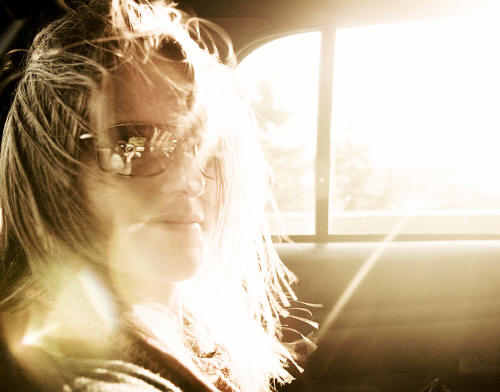
Chris and Larry: How did you get so good at it?
Chase Jarvis: I think itís in the same way that you build up your
ability to run fast or to make your muscles stronger. You lift weights.
The more weights you lift, the stronger you get. In the case of my
creative process, Iíve built up a callous, though thatís the wrong word,
but you just get used to it. And it didnít start out that way by any
stretch of the imagination.
The first time a friend said, ďHey, you should start a blog,Ē I just
thought it sounded very self-centered. But he said, ďNo, no, donít just
point it at your own stuff; point it at other peopleís stuff.Ē So the next
week I pointed it at some other peopleís photos. And then he said, ďWhy
donít you do a video?Ē And I thought, oh man, this is a lot of work. But
as soon as you start doing those things, you start feeling the benefit,
both personally and structurally. You start to see some social interaction
in the world. Maybe you create a conversation, and itís a motivator in and
of itself taking on a life of its own. And you get better at it and that
all goes back to being willing to throw it out there and fail, and throw
it out there and get feedback of all types. And you do get better at it.
Chris and Larry: What Iím hearing you say is something that Iíve
heard artists speak of many times. But people who are in the high pressure
world of commercial photography rarely think in terms of ďitís okay to
failĒ. If you want to keep a big client you have to produce. How do you
reconcile those two worlds, the art world where itís OK to experiment and
see what happens, and then the big-time world of the big corporations who
see you as someone who will produce the work they need? Do you feel that
you have to switch gears, or do you just handle it all with the same
attitude?
Chase Jarvis: I think that is one of the best questions Iíve been
asked in an interview in a long time. I havenít ever articulated this to
myself, but as you were asking the question, I started thinking.
I think that part of why I get hired and what people might like is that
once Iíve got the thing that the art director wanted in the can, now letís
turn this idea on its head. Iím not being a renegade for the sake of being
renegade. I got the shot that we talked about prior to getting here. But
itís about how can you bring the fearlessness and an experimental approach
to the commercial setting? Because itís very rarely the shot that you
think is going to be the shot that ends up in the campaign. Itís usually
one of these that are more adventurous, ones that are created in the
moment, rather than the ones that were drafted by the creative director
back at the agency.
Chris and Larry: So getting that one in the can is the first
priority, and once you feel that youíve covered your bases, and then you
continue to play and to experiment.
Chase Jarvis: Absolutely. And those are the ones that tend to be
the most successful pictures. And the weird part is that the reason you
end up getting hired is not because youíre able to be like a monkey and
take the pictures the art director drew, but itís because when youíre on
set, youíre able to create something that was unanticipated and exceeded
the original vision of the client.
And itís hard to do. Youíve got to kind of develop the balls to pull that
off. I donít want to sound like Iíve got this figured out because it has
been a huge trial and error process. You need to be dependable and be all
those things, but youíve also got to take the risk. Youíve got to swing
for the fence. Michael Jordan has 33 game-winning shots to his credit, but
heís also probably missed hundreds because heís not afraid to fail. If you
donít swing, you donít hit the ball. At the end of the day, you build up a
tolerance for the fear of risk associated around creating, and ultimately,
that is sort of a constant that you take into the next job.
Chris and Larry: Letís talk about your
personal work. You did a project called Songs for Eating and Drinking. How
did that come together?
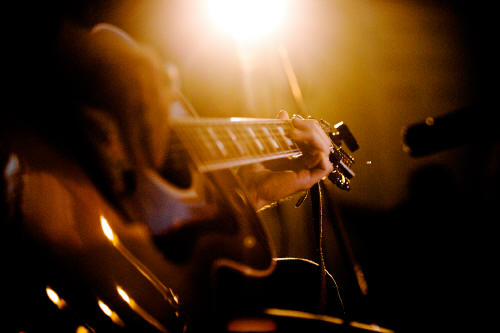
Chase Jarvis: The project was kind of born full-grown. And at its
core, the concept is a simple one, get a bunch of insanely talented
musicians together, and let them share songs, food, and drink. A friend of
mine, Michael Hebb, is kind of a food provocateur, and his favorite thing
in the world is putting amazing people together and cooking an amazing
meal. We got together and wanted to collaborate.
We found that the power is in everyone winning, everyone benefiting, and
what a richer place the world is. I personally stay interested because
itís invoking things that Iím genuinely passionate about. I love music, I
love food, I love creating and sharing.
Some of the artists that are at the table are very famous and theyíre used
to playing in front of audiences of thousands of people. What they really
want is to get back to their roots. And so the evening gives them an
opportunity to do just that.
When Pearl Jam fans get an opportunity to see Stone Gossard playing a
guitar with a rapper rapping over the top of him, totally impromptu in the
middle of a dinner, the fans love that.
So itís some sort of combination of these interdisciplinary ideas that I
feel like I get the most value from. Not that I donít love just taking a
picture or shooting a campaign or directing a commercial, but Iím really
excited when Iím doing what I love and the person across the table from me
is doing what they love.
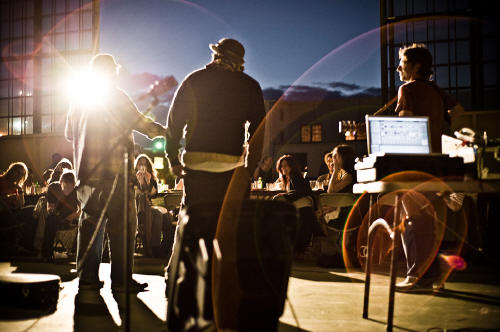
Chris and Larry: There can be real synergy bringing talented people
together in these great venues - but how do you get paid? Your success
infers that thereís a new business model thatís kicking in. Where does the
revenue come from?
Chase Jarvis: Itís the new model that lets creative people have
their own distribution channel, allowing us to share our personal work.
So letís say I finish a job and instead of buying a new couch or a new car
with the money, I put that into a personal project. Iím going to be able
to create a cool body of work that is going to make me feel alive and
bring the most out of me creatively. And that work will be responsible for
me getting my next job, maybe getting a cooler job, and having my personal
brand equity and my personal value as a creative be higher than the last
job that I did.
You wouldnít believe the phone calls, and theyíre not just a repeat of the
last job. And for the next ad, itís like, ďWell, I saw what you did with
Songs for Eating and Drinking and I loved the style.Ē If I hadnít done
that project then I wouldnít have gotten that call to shoot this ad
campaign and shoot it in a way that I wanted to shoot it. I would have
been asked to do it in the way that the art director did it, the way that
theyíd all seen it done before. So itís a great way to develop a personal
style and a great way to then get hired for that style.
I would advocate that throwing money at personal projects is in many ways
a stepping stone or a ladder to growth and evolution and ultimately jobs.
Those personal projects translate specifically into jobs for me.
Chris and Larry: That brings us to your new book, ďSeattle 100, The
Portrait of a City.Ē Can you tell us about how that came together? It
appears that it started as a personal project, and now youíve got a book
and a website.
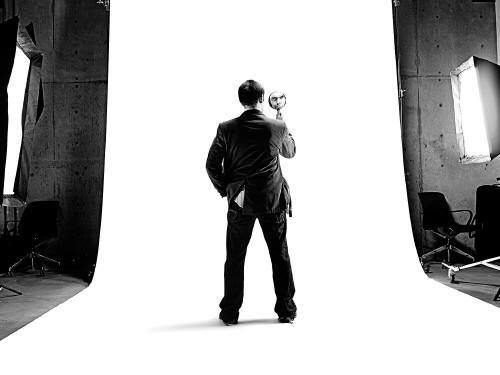
Jason Puccinelli
Chase Jarvis: It started out of realizing that I love Seattle. Iíve
had a home here almost my entire life, but at some point I realized that I
didnít know my city as well as I wanted to. Iím on the road a lot, most of
the work that I do professionally is not in Seattle. Itís all in major
advertising markets like New York, Los Angeles or London.
And so I started making a list of the people I found to be remarkable in
Seattle because I wanted to collaborate. Once I made a list of people that
were doing amazing things, I realized my project could be the list itself.
The first list was people that I knew, that would let me take their
picture and share their story with the world. And then I made another list
of people that I thought would be fascinating to meet that were in and
around Seattle. An important distinction here, these are not people like
Paul Allen, Bill Gates, Jeff Bezos, Howard Schultz, who are normally seen
as heroes in Seattle.
Over the course of the three years that it took me to complete the
project, I started to develop a vision for having a website that painted a
cultural ethnography around the photography that I had done.
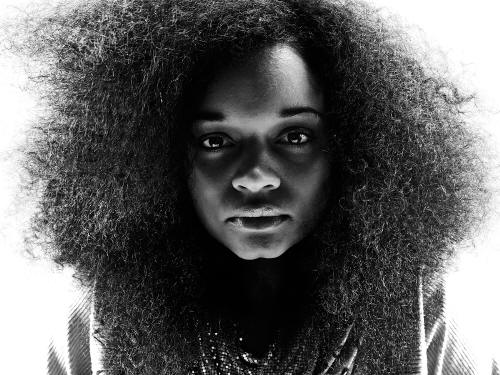
Laura "Piece" Kelley-Jahn
I had an idea, I started doing it, and the idea evolved. It turned into a
three-year long project documenting underground cultural leaders and the
places that they love in Seattle. Thatís why I called it Portrait of a
City because it gives you a picture of the city, but through the eyes of
100 people that I found interesting.
And the hope of the project was that it was going to allow
cross-pollination and encourage the city to take a look at itself. I was
hoping to break down barriers, you know architects hang around with the
architects, and the break dancers hang out with the break dancers.
Chris and Larry: People are used to coffee table books being $50 or
more. But if you go to Amazon and buy this with a discount, it costs about
$26. Is that part of the concept too, to make it more accessible?
Chase Jarvis: Absolutely. The democratization of creativity is a
theme in the stuff that Iím trying to share with the world. And for people
who couldnít afford the $26, weíve built a beautiful web site so they
could in some way experience the project.
The first price that was suggested was just under $70. We were able to
change that and to make it list for under $40. And on Amazon, with
discounts itís about $26. I think that at the core, thatís the right idea,
the right vibe.
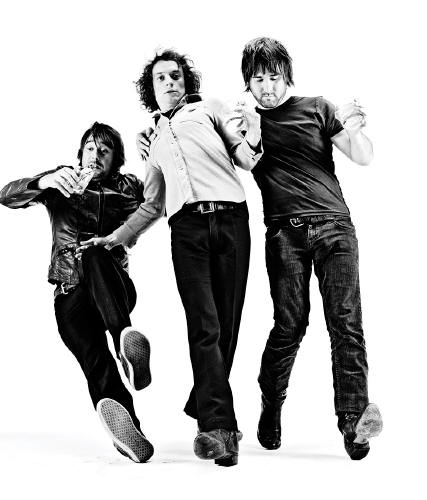
The Blakes
Chris and Larry: It seems everyone else monetizes sequel after
sequel, but that youíre always on to another project. Do you ever go
back and rework an idea?
Chase Jarvis: Oh my gosh. Thatís a great question too. I could name
so many things that Iíve done wrong. People point out how a project can be
a huge business model in and of itself, and I think sure, maybe in my next
life, or perhaps when Iím ďmore matureĒ Iíll be able to think more like
that.
I definitely created the Seattle 100 with the idea of doing a series of
these. It was an idea and a platform, if you will. And thatís in many
ways, what the Best Camera was as well. I have visions of future books, a
whole series of books that are from all over the world. But you touched on
an important point. It would definitely help some things if we slowed down
a little bit, but Iíve got to confess, I have a hard time with that. Iím
always excited about the next thing.
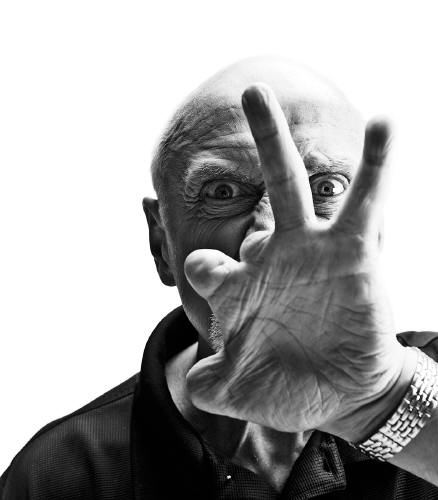
Cliff McCrath
Chris and Larry: Letís talk about your video work. Now that DSLRs
can capture full HD video, thereís convergence of possibilities. But a lot
of photographers donít see themselves as filmmakers. Yet you just jump
with both feet into it and have been very successful. Tell us a bit about
what got you excited about video and the new technology.
Chase Jarvis: I think the thing that put me there more than
anything else is, again, pure luck. I was the first photographer in the
world to get to use that technology. Nikon contacted me about the campaign
for the D90 and I got to play with the first camera that had that
technology. It was really blind luck to land the campaign and incredibly
inspirational to be able to ruminate on all of the possibilities. I
remember just trying to wrap my mind around exactly what that meant. It
was like wait a minute, this camera that costs $1,000, can produce a
cinematic look that just six months ago required equipment that cost
$100,000?
So after creating that campaign for Nikon and living with this camera I
felt like it was something that could change the world. And once you start
shooting and see the beautiful cinematic look, itís hard not to get
hooked. And back to my willingness to fail thing, I just kind of threw it
out there. I love it. Iím crow-like. I tend to fly after shiny stuff, and
this is a new kind of shiny thing. It just turned out that I really
enjoyed working as a director.
Chris and Larry: Many would say you need focus on the one thing
your best at. Do you think youíll be able to continue to progress on both
fronts with such speed?
Chase Jarvis: Oh, Iíve made a career out of not doing things that
weíre supposed to do. I categorically refuse to be pigeonholed any more.
You can do one thing better than the other, perhaps generate more revenue
off of one thing or the other. But I think itís an old mentality that says
you should only try and do one thing. Iím living proof that itís not the
way that the world works now.
Chris and Larry: Youíre constantly pushing at the high end, the low
end and finding new possibilities in between. Is that just part of your
creative process?
Chase Jarvis: I think so. It goes back to that curiosity thing that
we kind of touched on earlier. Being really curious and being willing to
fail. Overcoming fear Ė Iím afraid of a lot of things. Every time I do
something, thereís fear in there, but working it through and developing an
approach toward it has allowed me to do the things that Iím interested in.
Again, a crow flying around at all kinds of shiny stuff.
Chris and Larry: Whatís remarkable is the speed and ease that you
share the shiny things with all your friends. You seem to enjoy telling
people, well, this is how I do it. This is why. This is what the
possibilities are. You actually got flak from some of your peers when you
started out, that you wanted to share so much. And now it seems to be
whatís bringing you a lot of new creative possibilities.
Chase Jarvis: An ironic twist there, huh?
Chris and Larry: Well, it works that way sometimes.
Chase Jarvis: Yeah, it does. And itís very true. I wanted to be a
photographer, and I was trying to find other people who were interested in
talking about it, and I couldnít believe how few people were willing to
talk about the work that they were doing. I thought that was bullshit, so
I did the opposite.
Part of the reason I share so much information is because I learned so
much from other people. Itís the comments that I get back, the feedback,
and the amazing people that Iím able to meet through doing these projects,
itís insane. Iím a direct beneficiary. And I believe that the people that
Iím sharing with are also benefiting.
So again, weíre in a new era where there doesnít have to be a loser.
Everybody can win because mostly what weíre talking about is the movement
of pixels and images and information, which hopefully is the rising tide
which will float all the boats.
Chris and Larry: The days of dream assignments where a corporation
says ďTake six months and go to Africa and make some good picturesĒ are
gone, yet your whole energy seems to be saying there is something else
happening.
Chase Jarvis: Yeah, I think we are beginning to place value on
different things. Money is essential because it keeps a roof over your
head. But the way we measure things is evolving, I think.
We talk about it sometimes like our industry is the only industry thatís
changing. And thatís crazy. I mean arguably itís one of the faster
changing industries perhaps because of our tie to technology. Yes, the old
day of getting paid to go to Africa for six months to make some cool
pictures doesnít exist. But what has replaced it are things like
collaboration, understanding, learning, evolution of work, evolution of
job, growth of job, and expanse of experiences.
Chris and Larry: So how do you see increasing competition and
accelerating technology affecting photographers in the future?
Chase Jarvis: All that benefits us dramatically. The market
photographers compete in is often seen as a pie that we have to slice
thinner and thinner. But I know that there are more pictures being used in
more ways now than ever before. So it is up to our industry and us as
individuals to carve a new vision out of all of the volumes of media that
are being created, used and shared. Itís really about open-mindedness,
flexibility, and a willingness to change. Itís not going to look like it
did ten years ago. The photographer of the future will be an interesting
and different animal.
But I want to emphasize what an amazing time it is. Like Iíve said before,
weíve got still cameras that shoot video pictures and video cameras that
take stills. We all have access to sharing. We have new tools.
I donít want people to confuse a tool with something that will help your
business. A new camera is not going to make you a better photographer, no
more than a Twitter account is going to put your work on the desk of every
gallerist in the country. Those are just tools and in my personal
experience, all this takes a lot of hard work. Itís not for the
faint-hearted.
There are a million levels at which you can enjoy photography. But if
youíre interested in making it a profession and driving a career and
supporting yourself and a family and maybe a staff, itís not for the weak
stomach.
Chris and Larry: Well, youíre living the dream and earning a living
at it too. Thatís quite a combination.
Chase Jarvis: It feels great. I get to spend my time with amazing
people and amazing technologies and itís pretty wicked. I pinch myself
every day.
Chris and Larry: Are there any other projects of yours that you
would like to share with Shutterbug readers?
Chase Jarvis: I partnered with a friend of mine and created a
company called creativeLIVE. We point video cameras at the most talented
creative educators in the world - photographers, filmmakers, painters,
programmers, designers and basically give them a platform to share their
teaching message with the world. And weíve created an infrastructure and a
company around providing that education for free.
So if youíre anywhere in the world and you can access the Internet, I will
put the best creative educators in the world in front of you and you can
learn for free. The business the model is that if you want to keep it for
future viewing, then you pay to download it. That is an incredibly
exciting business model. And I think youíll see a lot more of it.


